Excerpts from Jim Conrad's
Naturalist Newsletter
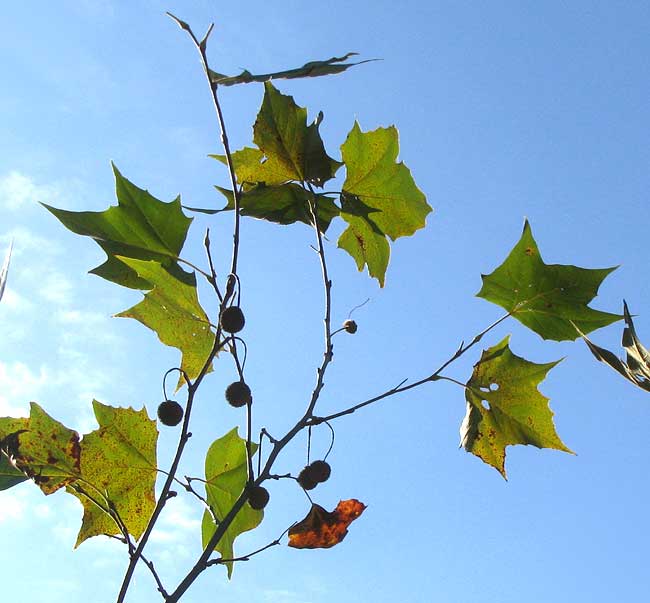
from the November 4, 2012 Newsletter issued from the valley of the Dry Frio River in northern Uvalde County, southwestern Texas, on the southern border of the Edwards Plateau; elevation ~1750m (~5750 ft); N29.62°, W99.86°; USA
SYCAMORES WITH FRUIT-BALLS
Sycamores are common along the little Dry Frio River behind the cabin. When I first saw them I wondered if they were the same species I'm so familiar with in the East. I'm used to massive sycamores that can reach 160 feet high and higher (50m) and can have colossal, almost bloated-looking trunks. However, the ones here are the size of apple trees and bear leaves maybe half the size of what I expect on a Sycamore. Out West there are California and Arizona Sycamores, so I wondered if we might have a species like that. But, no, our trees are regular American Sycamore, PLATANUS OCCIDENTALIS, maybe just stunted by the arid conditions here, or maybe they're a small race adapted for this climate. Whatever the case, nowadays they're bearing fruiting balls, as you can see above.
A close-up of a dangling ball, or fruiting head, is shown below:
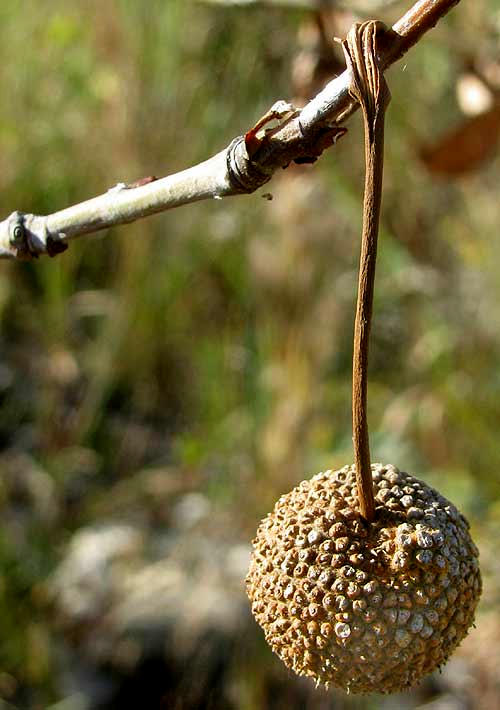
That ball is not a fruit, but rather a cluster of many fruits, each fruit having developed from a single tiny flower. Already some of the balls are breaking apart, especially where birds have pecked at them to feed on the fruits, which are achene-type -- dry, one-seeded fruits that don't split open when they mature. Among our birds the House Finches and chickadees seem to like them most. You can see three sycamore achenes, each with "parachutes" of stiff hairs arising from its base to help with wind dissemination, below:
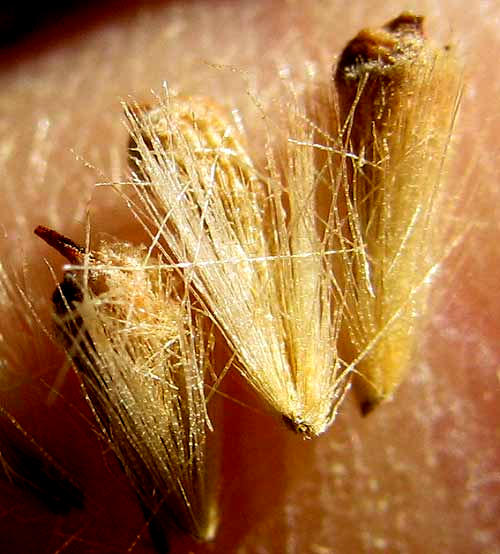
I'm used to seeing American Sycamores with single trunks but normally the sycamores on the Dry Frio's floodplain produce several trunks. Probably they develop by sprouting from former trunks mangled by the Dry Frio's waters, which can rage when there's lots of rain upstream on the Edward's Plateau. You can see a typical cluster of trunks below:
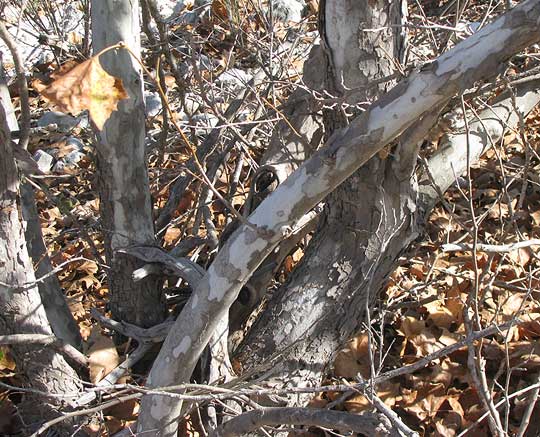
While I had a sycamore before me, I thought I'd show you one of its leaves' unusual petiole bases, below:
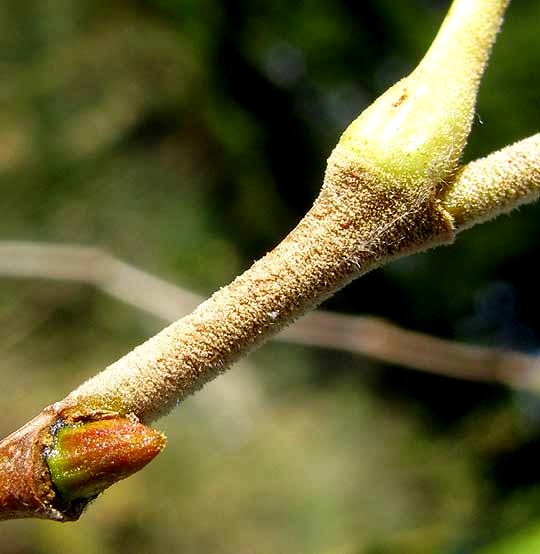
On the branches of most kinds of trees, leaf petioles arise below the buds from which stems will arise the next year. Much in contrast to that, in the above photo at the top, right you can see how the Sycamore's petioles practically surround their attendant bud, hiding them. When the leaf falls, it leaves a slender leaf scar almost encircling the bud, as can be seen at the picture's left.
American Sycamores extend much farther west and south than here in southwestern Texas. In eastern and east-central Mexico they occur along streams atop widely separated mountains. There they are relict populations left there as the last Ice Age ended and plants of the Eastern North American forest biome migrated back north, or else found the cooler environment they needed by migrating up in elevation.
from the December 30, 2012 Newsletter issued from the valley of the Dry Frio River in northern Uvalde County, southwestern Texas, on the southern border of the Edwards Plateau; elevation ~1750m (~5750 ft); N29.62°, W99.86°; USA
SYCAMORES TWIGS
Nowadays down on the little floodplain of the Dry Frio River behind the cabin some of our Sycamores are completely leafless while others retain quite a few leaves that are so brown and crisp that you wonder why a tree would keep them.
Some Sycamores that have lost all their leaves nevertheless are not entirely naked, for at each of their stem nodes where earlier a leaf had been attached now there's not only the usual bud containing embryonic tissue for next year's leaves and stems, but also a stipule. And few trees produce such large, leafy stipules as the Sycamore. You can see a typical Sycamore stipule with its attending bud below:
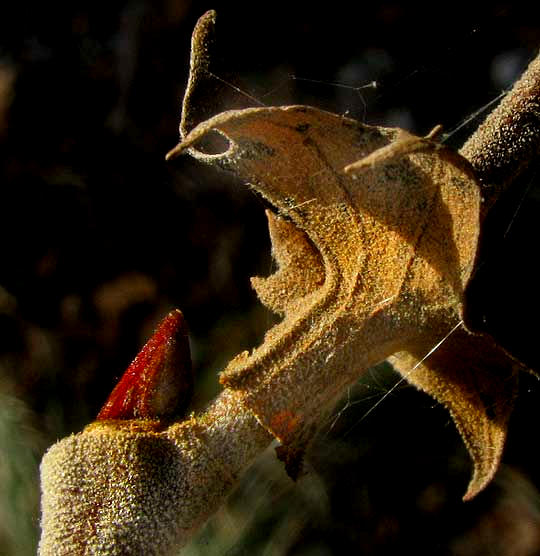
In that picture the stipule is the flaring, brown, leafy item occupying most of the top, right of the picture. Notice that its base encircles the stem, and that the base has come loose, leaving a barely visible ring around the stem, which is the stipular ring, or scar. Stipule scars on twigs of most tree species are small, not encircling the stems, or nonexistent, so the Sycamore's stipular rings make a good field mark if you're out identifying trees from their winter twigs.
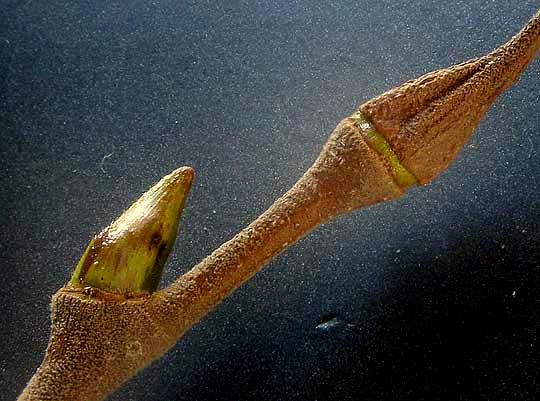
Above you see another Sycamore twig with a stipular ring encircling the stem at the base of the bud, but on this twig the stipule has fallen away. Also, something strange is going on in the picture's top, right corner.
In that picture the shriveling item exiting the top, right corner is the stem, or petiole, of a dried-up Sycamore leaf about to fall off. In fact, the petiole base has come loose from the stem so that a little of the twig's greenish-yellow terminal bud peeps through. Here you can see that the leaf's petiole base covers the bud like a cap, and that's another curious field mark for the Sycamore.
As a Sycamore's stipules leave stipular rings encircling the stem, when a Sycamore sheds a leaf, the leaf petiole leaves a narrow leaf scar practically encircling the conical bud, as you can see below:
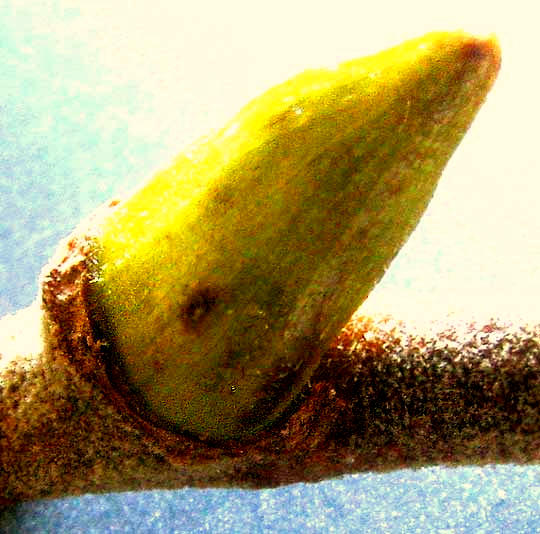
In that picture the bud-encircling leaf scar is like a shallow, narrow mote around the bud. Notice also that this Sycamore bud is covered with only one or two bud scales, which is very different from, say, an oak bud with its several scales, or a Magnolia bud with no scales at all.
So, all this goes to show that the Eastern Sycamore's winter twigs are very distinctive. In a way, however, that's sort of a waste of good field marks, since the Sycamore already is such a unique tree that almost everyone can identify it on sight. For, it has a white, blotchy bark unlike almost any tree, plus of all North American trees the Eastern Sycamore is one of the tallest, at around 165 feet (+50m) and with the greatest trunk diameter, reaching over 13 feet (+4m) across.
from the January 12, 2014 Newsletter issued from the Frio Canyon Nature Education Center in the valley of the Dry Frio River in northern Uvalde County, southwestern Texas, on the southern border of the Edwards Plateau; elevation ~1750m (~5750 ft); N29.62°, W99.86°; USA
SYCAMORE ABSTRACTIONS
Nowadays in quiet pools at the Dry Frio's edges often you find what's shown below:
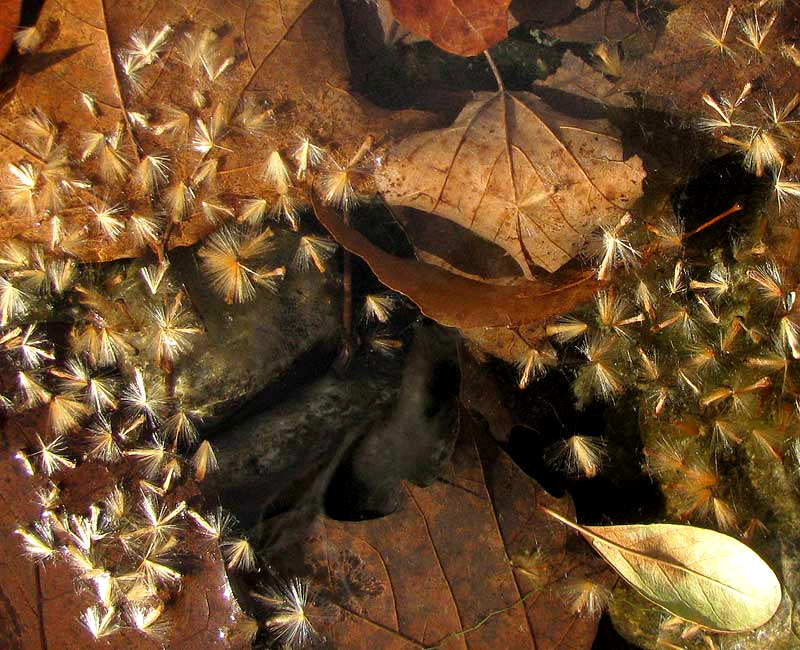
In water blackened with tannin leaked from decomposing leaves --mostly sycamore leaves -- the water's surface is scored with prodigious numbers of fuzzy, fly-like sycamore fruits. With help from their tawny-colored fuzz, the fruits have parachuted from disintegrating fruiting heads, or "sycamore balls," onto the water, their gatherings often composing pleasing abstract compositions such as that shown below:
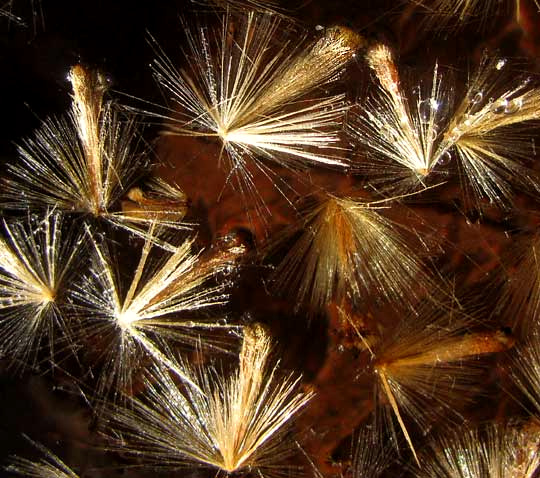
Some fruits fall onto land or dry leaves, where their structure is easier to make out. Several atop a crisply weathered sycamore leaf are seen below:
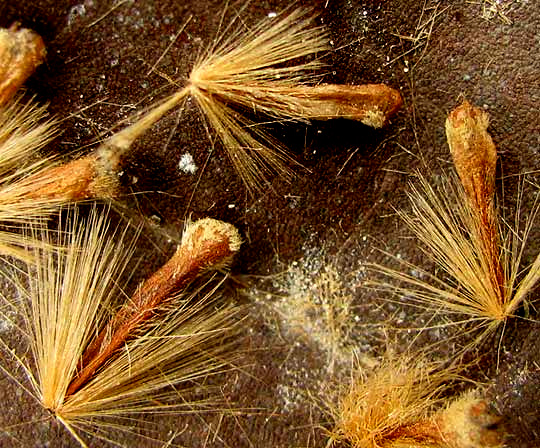
The clublike fruits are of the achene type, meaning that they are dry and upon maturity don't split open to release the single seed within them. In general, it's like a dandelion fruit, which also is an achene, except that the dandelion's long, parachute-forming hairs arise from a slender neck atop the achene, while the sycamore's long hairs arise directly from the achene's base.
Among birds documented feeding on sycamore fruits are finches, chickadees and juncos. Muskrats, beaver, and squirrels also eat them.
from the September 14, 2014 Newsletter issued from the Frio Canyon Nature Education Center in the valley of the Dry Frio River in northern Uvalde County, southwestern Texas, on the southern border of the Edwards Plateau; elevation ~1750m (~5750 ft); N29.62°, W99.86°; USA
REMARKABLE HAIRS ON YOUNG SYCAMORE LEAVES
Despite the lateness of the season, branches of American Sycamores along the little Dry Frio River still have small, silvery leaves unfolding at their branch tips, as shown below:
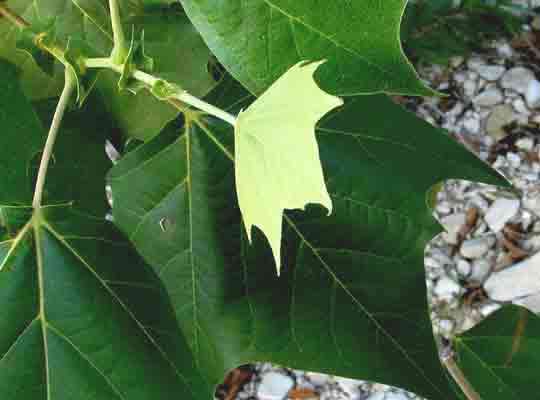
The immature leaves are heavily invested with a whitish, mealy kind of hairiness. Remembering that we have microscopes at Juniper House, I snipped off a freshly emerged leaf about the size of my thumbnail, put it beneath the dissecting scope, and saw what's shown below:
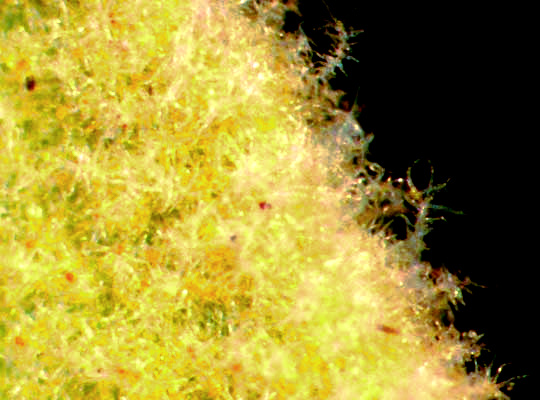
That's the bottom and side of a recently emerged leaf. Looking at the hairs flat-on, they looked like the kind of hair called "stellate," or "star-like," where several sharp hairs originate in various directions from a common base, like half of a sea urchin on the blade surface. However, hairs at the leaf's margins, seen from their side, reveal that they're actually "plumose," or "feather-like," consisting of a slender stem bearing numerous side branches.
Such hairs certainly do protect the developing leaf's delicate tissue from water evaporation, intense sunlight, temperature extremes and physical damage. Maybe a caterpillar would think twice about chewing into all that fluffy stuff, too.